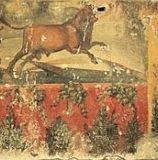
This upright evergreen shrub or small tree is native to southern Europe, North Africa, Western Asia, Macaronesia, and the Indian Subcontinent. It is a member of the Myrtaceae family that also includes clove and eucalyptus. Myrtle grows today in Pompei and was known there in ancient times. Myrtle pollen has been found in the garden soil of ancient Pompeii, and the shrub was included in the wall paintings of several houses in the ancient city. In a small garden located at rear of the House of L. Ceius Secundus (I.6.15), for example, is a wild animals scene with a realistic border of myrtle and ivy painted along the bottom of the wall. In addition to being valued as an ornamental garden plant, myrtle was used for its foliage in the making of chaplets and garlands. The ancient Roman poet, Horace (d 8 BCE), notes that he prefers garlands of “the simple myrtle” made at home to the ostentatious Persian ones. Pompeians, like many other Romans, made much use of garlands and chaplets. The home owner with myrtle growing in his atrium garden would have had easy access to foliage for home made ones, preferred by Horace. Photo Credit Wikipedia

Description: Myrtle is bushy, fine-textured, and has small lustrous bright green leaves that are aromatic when crushed. In late spring to early summer fragrant white to pinkish white flowers with numerous stamens are produced and followed by small blue-black edible berries. Although the flowers are not the main attraction of the shrub, they are a lovely delicate addition to the garden scene. Myrtle tolerates salt and some drought, thrives in heat but does not do well in humidity, drying winds, or wet soils. It takes well to shearing and can be pruned into formal hedges, topiary, and bonsai.
Size: 10′ H x 6′ W
Light: Full sun
Soil: Average, moist to medium dry, well-drained
Hardiness: Zones 9-11